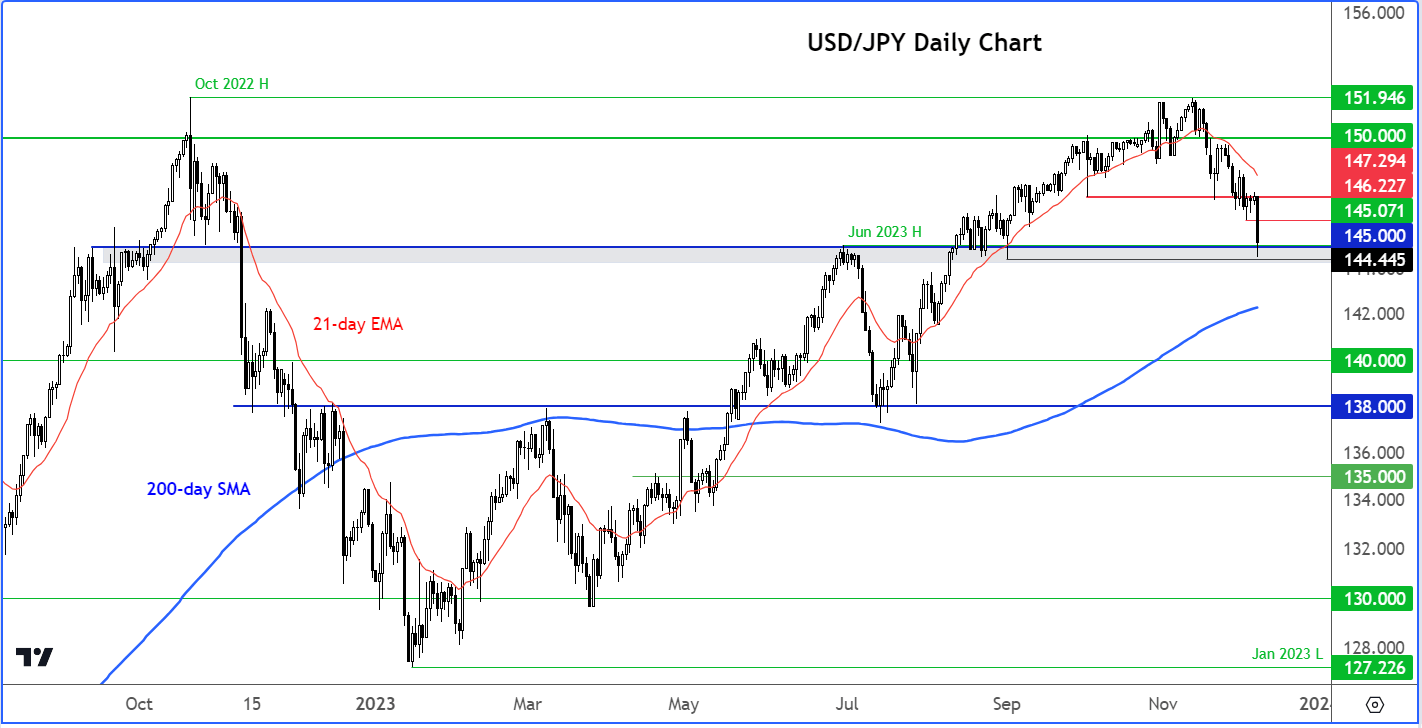
- Japanese yen analysis: Could BoJ abolish negative rates in April?
- Dollar turns lower but losses mild against other currencies
- USD/JPY technical analysis: 144.45 to 145.00 is an important support level
Video analysis: USD/JPY, GBP/USD, Gold, FTSE and Nasdaq
This morning saw some big moves in all yen crosses. The USD/JPY and EUR/JPY were down over 270 pips, while GBP/JPY was off by 300 pips at one stage. While these yen pairs all managed to bounce off their worst levels by mid-morning London session, they remained under intense pressure. The yen rally comes after BoJ Governor Ueda met Japanese Prime Minister Kishida earlier in the day, with investors anticipating a policy shift in Japan in the not-too-distant future.
Japanese yen analysis: Could BoJ abolish negative rates in April?
In recent months, one thing that has become quite clear is that the Bank of Japan has deferred any concrete indications of a policy shift until March or April of the coming year. They consistently referred to the spring wage negotiations for the next year, and this remains the same narrative mentioned by Ueda today, despite his increased openness to discussing a departure from the current ultra-easy policy.
It seems more likely that yen shorts have relinquished hope for a resurgence of the trend that dominated the majority of this year. The current focus in yen trading revolves around whether the BOJ will follow through after the wage negotiations, and traders are increasingly convinced that they may indeed do so.
Ueda said that the BoJ had “not made a decision yet on which interest rate to target once we end our negative interest rate policy.”
As my colleague David Scutt noted earlier, the choice of wording – “once”, not “if” – suggests the BOJ is maintaining its dedication to policy normalization, probably at the start of the fiscal year in April. The fact that investors have been advancing the anticipated schedule and extent of rate reductions by other central banks, this has had an even larger impact on the yen in recent weeks, with the Japanese currency rallying alongside bond prices.
If the BoJ increases its policy normalization rhetoric in the days and weeks ahead, then this could potentially lead to a situation where the Japanese yen appreciates significantly against the currencies of countries where the central bank is turning dovish – in order words, all major JPY pairs – as the spread between bond yields in Japan and those of the rest of the world, narrows further.
Dollar turns lower but losses mild against other currencies
Following a positive beginning to the week, the Dollar Index (DXY) has now started to decline again, mainly because of the big yen rally. However, outside of the influence of the USD/JPY, the DXY showed relatively modest losses against other currencies this morning.
In essence, the greenback maintains a holding pattern, and its overall trajectory could be contingent on the upcoming US jobs report on Friday, as well as the CPI data and FOMC meeting scheduled for the following week. The signals from FX and bond markets this week suggest that investors are incorporating the likelihood of a subdued NFP figure, implying the potential for a stronger dollar if the data doesn't prove excessively weak. However, given the significant improvement in risk appetite in recent months, any noteworthy dollar rally may be countered in favour of the yen and other more risk-sensitive currencies.
Concerning today's imminent data, I do not anticipate jobless claims to play a substantial role. Consequently, the USD/JPY could find resistance on any short-term recovery ahead of more significant macro events, starting with Friday's release of the US non-farm payrolls report.
The US dollar emerged relatively unscathed following Tuesday's conflicting US data releases. The unexpected drop in JOLTS job openings for October fuelled speculation of potential future Fed rate cuts, but the more current and stronger-than-expected ISM services PMI data for November provided a counterbalancing effect. Wednesday's unveiling of weaker ADP private payrolls data did not immediately trigger a dollar sell-off until Thursday's decline influenced by the yen.
Focus will turn to US labour market for remainder of this week
The dollar's resurgence earlier this week was partially credited to remarks made by Federal Reserve Chair Jerome Powell on Friday, where he pushed back against expectations for rate cuts. However, he acknowledged that interest rates were already sufficiently restrictive, aligning with market expectations that peak rates had been reached. With no further updates expected from Federal Reserve officials until the conclusion of the next FOMC meeting on December 13, the dollar's trajectory in the interim will largely depend on incoming data releases.
The first focal point is today's weekly jobless claims data, projected to increase to approximately 220K from the previous week's 218K. However, attention will swiftly shift to the nonfarm payrolls data on Friday. Over the last five months, there have been three instances of missing the headline jobs growth, a notable departure from the preceding 14 occasions characterised by consistent beats. The recent softness in jobs growth, while not alarming, indicates a cooling job market. This trend is also reflected in other labour market indicators, such as higher-than-expected jobless claims and a slightly elevated unemployment rate.
If the upcoming nonfarm payrolls data reveals a relatively weak figure, there is a possibility that expectations for an earlier-than-expected rate cut could exert downward pressure on the dollar once again. The consensus expectation for the headline print is 185K this time, compared to the previous month's 150K. It's crucial to monitor any subsequent revisions to the data.
USD/JPY technical analysis

Source: TradingView.com
The big drop in USDJPY from earlier means rates are now technically oversold and due a short-term bounce. Interestingly, the pair is now testing key support around or just below 145.00 handle (in the range between 144.45 to 145.00 area) where it had previously found strong support and resistance. With the short-term trend turning bearish, though, we could see the sellers return on any pullback to resistance levels. The next two key resistance levels are at 146.20ish and then at 147.30, levels which were previously support. The 200-day average is the next potential support level to watch at 142.30, should support around 144.45 to 145.00 area breaks down decisively.
-- Written by Fawad Razaqzada, Market Analyst
Follow Fawad on Twitter @Trader_F_R
How to trade with City Index
You can trade with City Index by following these four easy steps:
-
Open an account, or log in if you’re already a customer
• Open an account in the UK
• Open an account in Australia
• Open an account in Singapore
- Search for the company you want to trade in our award-winning platform
- Choose your position and size, and your stop and limit levels
- Place the trade












